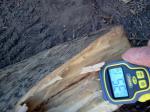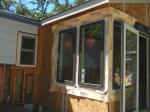If people cared as much about their buildings as they did their dinner – organic, gluten-free, and vegan shoppers would be demanding better buildings!
There are many similarities between building a house and baking a cake. There’s a basic recipe, ingredients are purchased and sifted through, there’s a rising process, add some pretty finishes – and ultimately someone tries to enjoy it. Just as some people later regret eating that cake… others live to regret moving into a newly renovated building. Ingredients matter.
As a Building Biology Environmental Consultant (BBEC) part of my job is to help design teams identify less-toxic building materials. There is a wide continuum of “how healthy” a building’s material palette can be, and determining the client’s priorities and budget constraints help steer the process.
Understanding Priorities
Building shoppers have different priorities. Some love aquatic life, some chase birds, and some wakeup in cold sweats about melting icecaps. Most of our clients are primarily concerned with the Indoor Environmental Quality (IEQ) of a building during its “use-phase.” The upstream (extraction, manufacturing, transportation) and downstream (biodegrade, reusable, landfill) part of its lifecycle matter – but are less important compared to how the materials, once installed, will affect their family’s wellbeing. Regardless of environmental priorities, budgetary constraints are often a trump card when exploring some extreme healthy-building measures.
Choosing Ingredients and Defining Performance
In a cake, ingredients may include granulated sugar and baking powder. There are different branded forms of sugar and baking powder, but you wouldn’t substitute these components with powdered sugar and brewers yeast. The same is true for building components. “Structural” components must perform a certain way, as must “waterproofing” components.
Performance cannot be compromised. The foundation supports a building, and the roof is to keep it dry. Engineers, architects, and builders accept responsibility for performance. Performance characteristics are often defined by the American Society for Testing and Materials (ASTM) testing standards. Compression strength for concrete, dryness for structural lumber, flexibility for caulk, durability for roofing materials, etc. These guidelines are in place for a reason and we never advocate sacrificing performance for health. Fortunately, it’s not a zero-sum game.
Researching Alternatives
Once you’ve identified the necessary components you can begin finding materials that are already branded “green.” An easy place to start is by reviewing books and databases. Another BBEC’s book, Prescriptions for A Healthy House, contains hundreds of recommended low-impact materials. GreenSpec, a paid online database from BuildingGreen, is another great resource. Another easy measure is relying on third-party “green certifications,” such as Green Label Plus for carpets, Green Seal for paints, etc. (Disclaimer: Don’t trust all certifications either!)








amazing home.. nice idea i love this one =)
Thank you for the reply. There are some great quotes out there about not eating anything that wouldn’t biodegrade or return to nature if left outside. Some are now trying to apply that to buildings!
What if at the end of a building’s life we could just remove the roof and let it biodegrade or “melt” back into the earth? Maybe someday… but today’s plastic and foam building products will be here for eons.
Some kid eating a mud-pie next to a rammed-earth or light clay/straw building would have been a nice photo too!
Be well,
Alex